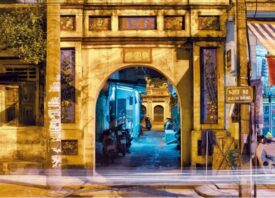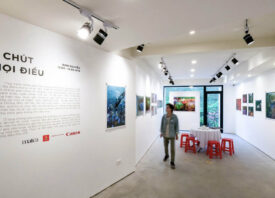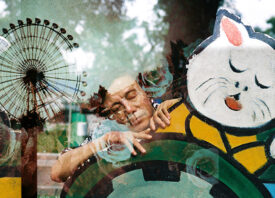Search this site
Hanoi’s Colorful Fruit Vendors Are a Joy to See


The moment Loes Heerink arrived in Hanoi, leaving her van to take in the sounds of traffic and honking, her eyes fell on a street vendor with a bike full of vibrant silk flowers. She grew up thousands of miles away in the Netherlands, but the sight immediately took her back home. When she was a teenager, her mother would ask her to pick up the groceries and carry them back on her bike. Though she once complained that they were too heavy, she learned in Hanoi that people can carry almost anything by bike.
That moment of inspiration eventually gave birth to Merchants in Motion, published as a book in 2018. As she discovered, merchants in the bustling streets of Hanoi carry all sorts of colorful goods: flowers, fruit, veggies, and more–all balanced in baskets. Heerink photographed them from nearby bridges, waiting for hours for the right vendor to pass. On one occasion, she waited five hours only to return home with no photos that day.
From the beginning, she longed to photograph one of the flower vendors. “While waiting for a flower vendor (which took weeks, if not months), I passed the time photographing other vendors,” she remembers. “I really started to enjoy my time up the bridges. Just passing the time looking at everything that happened downstairs. Sometimes, a vendor on foot would cross the bridge and she would sit down with me while I ate some of her goods.”
Most of the vendors she met in Hanoi were women, and many were migrant workers. “The women I talked to start very early in the morning and work until late at night,” Heerink says. “They buy their goods in the night market and work until late at night. “A lot of the vendors walk kilometers a day. Some tens of kilometers. Just walking around the town. It’s often the same cycle so customers know they are coming.”
It’s hard work, and many of the vendors don’t get to return home often, though that usually depends on the ages of their children. “To save money, they live with other vendors and they bring rice from home,” the photographer explains. “It’s cheaper over there.”
After making the pictures, Heerink tried to find the women again to show them the final prints. She found some of them. “One vendor, Hoa, even bought fruits with pink nets around them because she thought it would look pretty for the photo,” she remembers. “So sweet!”
The photographer lived in Hanoi from 2012 to 2015, and she still misses it. “It’s a city with a soul,” she tells me. “People are kind, and the streets are busy; the city is green, and there is always something to see or do. What I miss the most about Hanoi is the social aspect. Going out for dinner, or, when you don’t have anything to do, just sitting on the porch in front of the house with the neighbors.
“Even though my Vietnamese isn’t that good, it was always cozy sitting with the neighbors on the street, sipping iced tea. I get homesick for Hanoi just thinking about the food. Some of my friends still live there. And my landlord and landlady–I would like to see them again too!”
Of course, she misses the vendors too. Heerink still remembers the day she got that first flower picture. “I did a little dance after I took the shot,” she says. “I saw her coming towards my spot, and I was so afraid she would turn into the Old Quarter, but she didn’t. She crossed underneath the bridge!” As it happens, it was International Women’s Day. “I hope street vendors will always have a place in Hanoi,” the artist admits. “They really brighten up the city.”










